
Royal Botanic Gardens, Kew, is a non-departmental public body in the United Kingdom sponsored by the Department for Environment, Food and Rural Affairs. An internationally important botanical research and education institution, it employs 1,100 staff. Its board of trustees is chaired by Dame Amelia Fawcett.
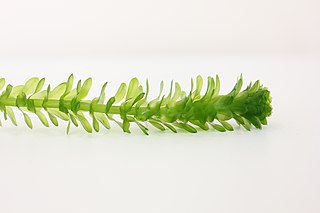
Egeria is a genus of three species of aquatic plants in the family Hydrocharitaceae described as a genus in 1849. native to warm-temperate South America.
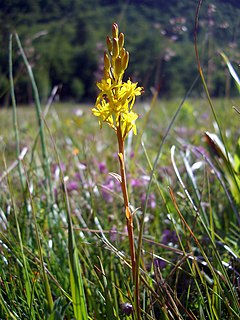
Narthecium is a Eurasian and North American genus of herbaceous flowering plants. This genus was traditionally treated as belonging to the family Liliaceae, but the APG II system of 2003 placed it in the family Nartheciaceae.

Hyaenanche globosa is a species of plant under the family Picrodendraceae. It is the sole member of the genus Hyaenanche and the subtribe Hyaenanchinae. It is endemic to Cape Province in South Africa.
Heywoodia is a genus of plants in the Phyllanthaceae first described as a genus in 1907. It contains only one known species, Heywoodia lucens, native to eastern, southeastern, and southern Africa.
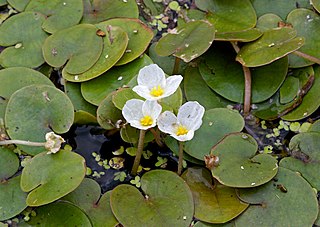
Hydrocharis is a genus of aquatic plants in the family Hydrocharitaceae described as a genus by Carl Linnaeus in 1753. It is widespread across much of Europe and Asia, plus a few scattered locations in Africa. It is also reportedly naturalized in parts of North America.

Dioscorea oppositifolia is a type of yam (Dioscorea) native to Myanmar (Burma) and to the Indian Subcontinent.

Syringodium is a genus in the family Cymodoceaceae described as a genus in 1860. It is found along shorelines of tropical and subtropical marine environments.
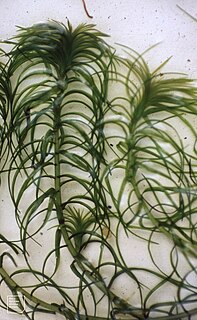
Lagarosiphon is a genus of aquatic plants described as a genus in 1841. It is native to Africa and Madagascar.
- Lagarosiphon cordofanus(Hochst.) Casp. - Cameroon + Ethiopia to Namibia + Mpumalanga
- Lagarosiphon hydrilloidesRendle - Ghana, Kenya, Uganda
- Lagarosiphon ilicifoliusOberm. - Uganda to Namibia
- Lagarosiphon madagascariensisCasp. - Madagascar
- Lagarosiphon major(Ridl.) Moss - Zimbabwe, Botswana, Lesotho, South Africa
- Lagarosiphon muscoidesHarv. - Mali to Sudan to KwaZulu-Natal
- Lagarosiphon rubellusRidl. - Angola
- Lagarosiphon steudneriCasp. - Ethiopia
- Lagarosiphon verticillifoliusOberm. - Mozambique, Zimibabwe, KwaZulu-Natal, Swaziland, Mpumalanga, Limpopo
The World Checklist of Selected Plant Families is an "international collaborative programme that provides the latest peer reviewed and published opinions on the accepted scientific names and synonyms of selected plant families." Maintained by the Royal Botanic Gardens, Kew, it is available online, allowing searches for the names of families, genera and species, as well as the ability to create checklists.

Nechamandra is a monotypic genus of an aquatic plant family Hydrocharitaceae. The sole species is Nechamandra alternifolia. It is found in slow moving fresh water.

Blyxa is a genus of an aquatic plant of the family Hydrocharitaceae described as a genus in 1806.

Allium libani is a species of wild bulbous plant geophyte of the genus Allium, belonging to the family of Amaryllidaceae. Allium libani is endemic to the Middle East in Lebanon and Syria.
Appertiella is a genus of an aquatic plant of the family Hydrocharitaceae described as a genus in 1982. There is only one known species, Appertiella hexandra, endemic to Madagascar.

Limnobium, common names spongeplant and American frogbit, is a group of aquatic plants in the Hydrocharitaceae described as a genus in 1814. It is widespread in freshwater environments in Latin America, the West Indies, and the United States.
Maundia is a genus of alismatid monocots, described in 1858. Maundia was formerly included in the family Juncaginaceae but is now considered to form a family of its own under the name Maundiaceae. It contains only one known species, Maundia triglochinoides, endemic to Australia.
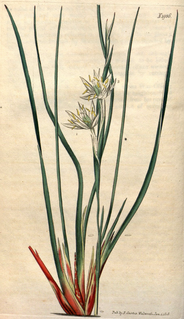
Pleea is a small genus of flowering plants described as a genus in 1803. There is only one known species, Pleea tenuifolia, the rush featherling, native to the southeastern United States.
Eremitis is a genus of bamboo plants in the grass family, that is endemic to Brazil.
Bambusa cerosissima is a species in the genus Bambusa, the clumping bamboo.
Plants of the World Online is an online database published by the Royal Botanic Gardens, Kew. It was launched in March 2017 with the ultimate aim being "to enable users to access information on all the world's known seed-bearing plants by 2020". The initial focus was on tropical African Floras, particularly Flora Zambesiaca, Flora of West Tropical Africa and Flora of Tropical East Africa.












